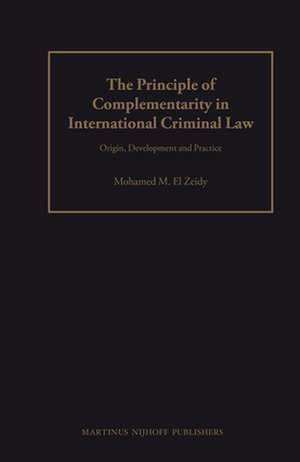The Principle of Complementarity in International Criminal Law: Origin, Development and Practice
Autor Mohamed El Zeidyen Limba Engleză Paperback – 16 sep 2008
“The concept of complementarity lies at the heart not only of the Rome Statute of the International Criminal Court, it is in many respects the underlying paradigm of international criminal justice as a whole. In this important study, Mohamed El Zeidy has drawn on historical sources, tracing the evolution of the concept and then showing how it has become operationalised in the first cases before the International Criminal Court. This book belongs in the library of every international criminal lawyer”.
Prof. William A. Schabas, OC MRIA
National University of Ireland, Galway.
Preț: 749.58 lei
Preț vechi: 914.13 lei
-18% Nou
Puncte Express: 1124
Preț estimativ în valută:
143.43€ • 150.13$ • 119.38£
143.43€ • 150.13$ • 119.38£
Carte indisponibilă temporar
Doresc să fiu notificat când acest titlu va fi disponibil:
Se trimite...
Preluare comenzi: 021 569.72.76
Specificații
ISBN-13: 9789004166936
ISBN-10: 9004166939
Pagini: 366
Dimensiuni: 160 x 240 x 28 mm
Greutate: 0.79 kg
Editura: Brill
Colecția Brill | Nijhoff
ISBN-10: 9004166939
Pagini: 366
Dimensiuni: 160 x 240 x 28 mm
Greutate: 0.79 kg
Editura: Brill
Colecția Brill | Nijhoff
Notă biografică
Mohamed M. El Zeidy, holds a Ph.D. in International Law and an LL.M. in International Human Rights Law from the Irish Centre for Human Rigths, National University of Ireland, Galway. He also holds an LL.M. in Public Law from Cairo University, a Lisence en Droit and Bachelor of Police Sciences from the Police College in Cairo. He served as a Judge, Senior Public Prosecutor and Public Prosecutor at the Egyptian Ministry of Justice. He is a member of the Egyptian Society of Criminal Law and the International Association of Penal Law. He has published widely in the area of International Criminal Law. He is currently a Legal Officer at the Pre-Trial Division of the International Criminal Court. This work was finalised prior to the current employment at the ICC. The views expressed in it do not necessarily reflect those of the International Criminal Court or the Egyptian Ministry of Justice.
Cuprins
Excerpt of table of contents:
Introduction; Part A: Chapter I: Development of the Law on Complementarity between 1919 – 1937: 1. The Treaty of Versailles; 2. Other Peace Treaties (St Germain-En-Laye, Trianon, Neuilly-Sure-Seine, and Sèvres); 3. The 1920 Advisory Committee of Jurists; 4. The 1922–1924 Conferences of the International Law Association; 5. 1925 Inter-Parliamentary Union Conference; 6. 1926 International Congress of Penal Law; 7. 1937 League of Nations Convention for the Creation of an International Criminal Court; Concluding Observations; Chapter II: The Development of the Law on Complementarity between 1941-1994: 1. London International Assembly; 2. International Commission for Penal Reconstruction and Development; 3. Draft Convention for the Establishment of a United Nations War Crimes Court prepared by the United Nations War Crimes Commission; 4. The Nuremberg International Military Tribunal; 5. The Principle of Complementarity in the Drafting History of the Genocide Convention; 6. The Role of the International Law Commission in the Development of the Principle of Complementarity (1949-1994); 7. The Primacy of the Ad hoc Tribunals; Concluding Observations; Part B: Chapter III: The Principle of Complementarity in the International Criminal Court’s Statute: 1. The Rome Statute Complementarity Model; 2. The Impact of Human Rights Bodies’ Decisions on Complementarity Determinations; 3. The Practice of Self-Referrals and Waivers of Complementarity; Concluding Observations; Chapter IV: Complementarity-Related Provisions (Articles 18 – 20); 1. Preliminary Rulings Regarding Admissibility in the Rome Statute Complementarity Model; 2. Challenges to the Jurisdiction of the Court or the Admissibility of a Case; 3. Consequences of a Self-referrals and Waivers of Complementarity in Light of Articles 18 – 19 and 53; 4. The Relationship between Complementarity and Ne Bis In Idem; 5. Final Thoughts on Complementarity: Positive – Dynamic versus Traditional Complementarity; Concluding Observations; Conclusions; Bibliography; Table of Cases; Index.
Introduction; Part A: Chapter I: Development of the Law on Complementarity between 1919 – 1937: 1. The Treaty of Versailles; 2. Other Peace Treaties (St Germain-En-Laye, Trianon, Neuilly-Sure-Seine, and Sèvres); 3. The 1920 Advisory Committee of Jurists; 4. The 1922–1924 Conferences of the International Law Association; 5. 1925 Inter-Parliamentary Union Conference; 6. 1926 International Congress of Penal Law; 7. 1937 League of Nations Convention for the Creation of an International Criminal Court; Concluding Observations; Chapter II: The Development of the Law on Complementarity between 1941-1994: 1. London International Assembly; 2. International Commission for Penal Reconstruction and Development; 3. Draft Convention for the Establishment of a United Nations War Crimes Court prepared by the United Nations War Crimes Commission; 4. The Nuremberg International Military Tribunal; 5. The Principle of Complementarity in the Drafting History of the Genocide Convention; 6. The Role of the International Law Commission in the Development of the Principle of Complementarity (1949-1994); 7. The Primacy of the Ad hoc Tribunals; Concluding Observations; Part B: Chapter III: The Principle of Complementarity in the International Criminal Court’s Statute: 1. The Rome Statute Complementarity Model; 2. The Impact of Human Rights Bodies’ Decisions on Complementarity Determinations; 3. The Practice of Self-Referrals and Waivers of Complementarity; Concluding Observations; Chapter IV: Complementarity-Related Provisions (Articles 18 – 20); 1. Preliminary Rulings Regarding Admissibility in the Rome Statute Complementarity Model; 2. Challenges to the Jurisdiction of the Court or the Admissibility of a Case; 3. Consequences of a Self-referrals and Waivers of Complementarity in Light of Articles 18 – 19 and 53; 4. The Relationship between Complementarity and Ne Bis In Idem; 5. Final Thoughts on Complementarity: Positive – Dynamic versus Traditional Complementarity; Concluding Observations; Conclusions; Bibliography; Table of Cases; Index.
